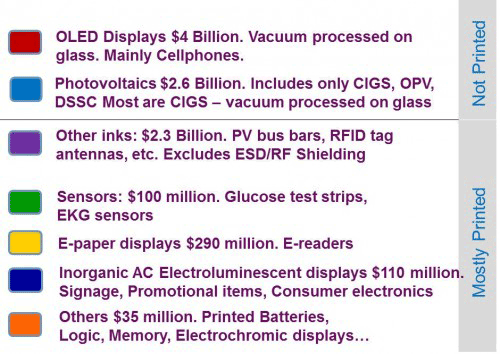Printed and Potentially Printed Electronics Reach $9.4 Billion in 2012
BY RAGHU DAS, CEO
IDTechEx
www.IDTechEx.com/pe
IDTechEx find that the market for printed and potentially printed electronics in 2012 will be $9.4 Billion. This includes devices not yet printed today but which are moving towards being printed. Of this market, 30% of the devices studied are made predominately by printing, and 6% are on a non-rigid substrate.
Main Successes
There are four main markets that make up 98% of this figure, which are:
• OLED displays, driven by the need to differentiate smart phones. Samsung has led much of the investment, production and use of OLED displays in its smart phones, seeing significant sales over the past 12 months. These OLED displays are not printed and are not flexible in the main. Continued demand in 2012, along with OLED displays of similar sizes being adopted by others, will see a $4 Billion spend on OLED displays (display module value) in 2012.
• In 2012 $290 million will be spent on e-paper material (excluding the value of the TFT backplane). In e-readers, this technology has created a market of several billion dollars if we include the value of the e-readers and content. However, the Holy Grail is color, with electrophoretic versions and other technologies (such as electrowetting) being pursued.
• Conductive inks, used predominately for photovoltaic (PV) bus bars and other applications such as antennas, flexible connectors, smart packaging etc, see a $2.3 Billion spend on the ink alone. This excludes spend on conductive ink for shielding/static discharge applications and membrane circuits, where the sectors are mature. Almost all of this is flake-based ink.
• In addition, almost $2.6 Billion will be spent on CIGs based photovoltaics in 2012 – but almost all of this is non printed and on glass. However we include this as part of the big picture because there is significant effort pursuing printing to manufacture CIGs.
The full breakdown is shown in the following figure:

Printed and Potentially Printed Electronics Market Size by Component Type in 2012. (Source: Printed, Organic & Flexible Electronics Forecasts, Players & Opportunities 2012-2022 www.IDTechEx.com/pe)
IDTechEx believe the OLED display market will rise to $30 Billion in 2022, and of that 20% will be predominately printed and 17% on a non rigid substrate. Indeed, significant research and investment to printed OLEDs is happening now, and with Samsung's decision to spin out its LCD business and focus on OLED, IDTechEx expect the use of OLEDs to accelerate compared to the paltry growth until a few years ago.
IDTechEx expect OLED lighting to become a $1 billion market by 2019. OLED lighting panels need to scale up in size to reduce cost and face competition from LED lighting which is now making inroads into most forms of lighting, in addition to experiencing new technical developments such as printed LED lighting.
The IDTechEx Printed Electronics Europe event in Berlin, April 3-4 features panels consisting of the world's leading companies in displays and solid state lighting discussing the future of these technologies. (http://www.PrintedElectronicsEurope.com ).
Hot topics
Sales of printed batteries, logic and memory remain very small but a few aspects are coming together to address that. This includes the creation of useful “building blocks” in the form of memory addressed by printed transistors, and now combining that with sensors which have applicability to a wide range of markets, and moves away from those trying to sell a transistor to those having a useful product to buy.
While metal flake ink is predominately used today for screen printing PV bus bars, there is growing interest to use inkjet printable ink in order to reduce the risk of breaking the ever thinning silicon PV cell by having a non contact deposition method. Particle free metallic ink, graphene based inks and copper are now in development or commercial use in a range of applications including tamper and theft monitoring of retail packages.
Indium Tin Oxide (ITO) is still more than 95% of the $3.5 billion transparent conductive film market. Indium is subject to supply restriction and its price has varied by a magnitude in the last ten years. It is required primarily for photovoltaics, displays and touch screen applications – enormous markets. Alternatives to ITO include transparent organic materials, finely printed conductive grid meshes and other ways of patterning metal 'strands'. Some even use copper rather than silver to reduce cost. Others are progressing carbon nanotubes and graphene as a viable alternative and companies with different technologies are beginning to make some inroads, particularly in touch screen panel applications.
The $63 Billion Opportunity in 2022
Ten years from now, of all the components assessed, IDTechEx find that the market opportunity will be $63 Billion. However, of that, 45% of the components will be predominately printed and 33% on a non-rigid substrate, given the time and investment needed to move to printing manufacturing processes or flexible substrates.
New Research
All of these trends, including detailed ten year forecasts by component, territory, material type, substrate type and printed vs non printed manufacturing, are covered in the new IDTechEx report “Printed, Organic & Flexible Electronics Forecasts, Players & Opportunities 2012-2022” www.IDTechEx.com/pe. This report provides the most comprehensive view of the topic. It covers case studies of where printed electronics has been used, why and the results. It looks at new products that are imminently emerging and their prospects for success. The technical barriers and commercial barriers are listed and prioritized, as well as progress to overcome these. For the full contents see www.IDTechEx.com/pe.
To learn more about the topic attend Europe's leading event on the topic in Berlin, April 3-4 where adopters and suppliers come together. See www.PrintedElectronicsEurope.com for details. It explores the applications with many end users presenting their needs and experiences and it covers appraisal of all the key technologies. ■
Advertisement
Learn more about IDTechEx





